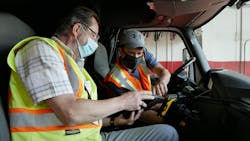It’s been eight years since Kriska Holdings Ltd. and the Mullen Group’s Mill Creek Motor Freight combined to form Kriska Transportation Group (KTG).
Since then, KTG has grown to become one of the largest privately held transportation companies in Canada with 11 operating companies under its umbrella. Combined, its companies employ more than 1,200 people and operate 950 trucks and 2,000 trailers throughout North America, with services ranging from cross-border dry van, reefer, and flatbed to regional retail transportation services.
As KTG expanded its operation, the company continued to prioritize fleet safety.
“Driver safety is something that is deeply rooted in the culture at KTG,” said Eugenia Churilov, KTG director of safety, compliance, and security. “Customers want to work with a company they can trust, knowing their freight will be delivered on time and safely. Over the years, our operating companies have received recognition by the Truckload Carriers Association (TCA) for fleet safety and we’ve had companies named as finalists for the Best Fleets to Drive For program. Our companies are also frequently recognized for fleet safety by organizations here in Canada.”
See also: Carriers that put people first win Best Fleets to Drive For honors
Churilov, who has more than 25 years of experience in fleet safety and compliance, joined KTG in 2019. As the company continued to grow, Churilov recognized the need to consolidate and create uniform safety programs each operating company would follow.
To accomplish this, Churilov met with each KTG operating company to evaluate their safety programs with the intent to design a safety strategy that blended best practices she observed with successful tactics she had used prior to joining the company.
“What we found was many of our companies had effective educational programs already in place,” Churilov said. “By building a safety program with the best training programs, policies, and technologies we saw our companies using, we improved the efficiency and effectiveness of our programs which has resulted in fewer driver-related incidents.”
Today, all KTG operating companies use a training strategy that blends online, classroom, and practical training programs for both drivers and office staff. Since KTG companies offer a variety of services, course material specific to each fleet’s service offerings are handled by safety managers at the carrier level.
In most cases, KTG companies use online training through CarriersEdge, to deliver initial training or information during the onboarding process of new drivers and for ongoing or refresher and remedial training. When new drivers are hired, they first complete assigned online training and other pertinent documents, then they attend in-class training and meetings for a more in-depth review and training of topics better suited for a discussion-based environment. Practical or “hands-on” vehicle training follows, with drivers receiving training based on prior experience.“We’ve found online training tools offered through the CarriersEdge platform to be a more efficient and less disruptive way to educate drivers since they can complete training on their own time. We use the time we meet in person to cover training items that are more complex or better discussed as a group and to answer questions drivers may have,” Churilov said.
According to Churilov, the interactive design and topics covered in courses offered by CarriersEdge and back-end management tools is what led KTG to integrate the online training provider into its safety program.
KTG companies deliver online courses to drivers on topics such as defensive driving, hours of service, vehicle inspection, winter driving, distracted driving, healthy eating and more across all its companies. Courses that cover topics specific to its operating companies, such as transportation of dangerous goods, cargo securement, and food safety are assigned to drivers. Select nondriving roles with KTG companies, such as dispatchers, are required to complete many of the courses drivers take since they work closely with drivers.
“CarriersEdge’s library of comprehensive courses matches well with the topics we need to cover across our operating companies and the information provided in the courses is regularly updated so we know the content is always relevant,” Churilov said. “Plus, courses are engaging and interactive, which helps drivers retain the information being taught. The online portal helps us track driver progress through the courses and better manage training-based decisions based on the results of the completed courses.”
See also: How to get the most from online training
In addition to courses offered through CarriersEdge, KTG develops custom courses on topics that are specific to company policies and operations that are uploaded to the CarriersEdge portal for employee assignment and completion tracking purposes.
As part of its training programs, KTG companies assign new or refresher online courses to drivers several times throughout the year. Based on test or quiz results following completion of an assigned course, KTG safety managers can assess a driver’s performance and whether additional training is needed.
“If we notice a trend with questions that are commonly answered incorrectly or low test results on a course altogether, we know to follow up with those drivers or plan a time for them to come in and meet with a safety manager and go over the topics more thoroughly to help them better understand the material,” Churilov said. “If we see isolated issues where one or a few drivers require additional support, we can work with them individually.”
On the road, trucks are equipped with the latest driver safety technologies to support best driving practices and track driver performance. KTG companies rely on its driver scorecard reports, which are analyzed monthly, as well as footage captured by dashcams to determine if remedial or “corrective” training is needed for a driver.
See also: How to reduce the symptoms of driver turnover
“If a safety manager, for example, notices a driver is involved in reoccurring hard braking events, they can look at the footage and make a determination on the best way to address the issue—whether additional training and education may help prevent these incidents moving forward or if another form of action is needed,” Churilov said. “Our driver scorecard reports allow us to be proactive in managing our safety programs and resolve problems that, if left unchecked, could lead to a bigger issue down the road.”
Since deploying a uniform safety program, KTG companies collectively have seen improved CSA scores. When KTG meets with its insurance provider, the company’s risk assessment is “the best in class” according to Churilov, and that they’re often told the company is among industry leaders in terms of overall safety. Documentation of its safety programs—through scorecards, safety technologies and CarriersEdge—helps the company maintain a “paper trail” of what the company is doing to stay safe, which in turn helps with insurance. It also adds a level of protection in the event the company finds itself in court. Proof of training delivery and completion of CarriersEdge courses are saved in the online portal.
“Informed drivers are safer drivers. Being proactive when it comes to training and working with drivers on safe driving practices is key to maintaining a good safety culture,” Churilov said. “Taking advantage of safety tools such as online training and scorecards helps us maintain an effective safety program.”
About the Author
FleetOwner Staff
Our Editorial Team
Kevin Jones, Editorial Director, Commercial Vehicle Group
Josh Fisher, Editor-in-Chief
Jade Brasher, Senior Editor
Jeremy Wolfe, Editor
Jenna Hume, Digital Editor
Eric Van Egeren, Art Director

